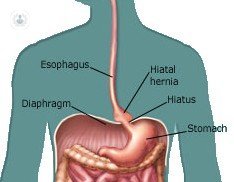The hiatal hernia explained
Written by:Hiatal hernia is a condition in which a part of the stomach slips up into the chest through the opening in the diaphragm (the hiatus) which normally just contains the oesophagus.

The most common type of hiatal hernia is a sliding hernia. This is when the lower oesophageal sphincter is pushed up into the chest cavity away from the hiatus, leading to symptoms of heartburn and gastric reflux.
The other kind of hiatal hernia is a para-oesophageal hiatus hernia where the stomach slips up into the chest to lie besides the oesophagus. This kind of hernia is less common, but is more of a cause for concern.
Is a hiatal hernia life threatening?
Most hiatus hernias are not life threatening.
However, a para-oesophageal hiatus hernia can on rare occasions be life-threatening, if the hernia twists in the chest resulting in a loss of the blood supply to the stomach (ischaemia) and perforation of the stomach into the chest cavity.
How can a hiatal hernia be treated?
Most small, sliding hiatal hernias do not require surgical treatment, and can be treated with medication and lifestyle changes such as eating smaller meals more regularly, avoiding lying down for three hours after eating or drinking, and removing certain foods from your diet.
Troublesome hiatal hernias can be repaired using keyhole surgical techniques, although open surgery may still be required for particularly large hernias.
What are the possible complications of hiatal hernia surgery?
Complications of hiatal hernia surgery include the rare complications of any  surgery such as bleeding and infection.
surgery such as bleeding and infection.
Specific complications to hiatal hernia repair include a difficulty in swallowing solids, which is usually temporary.
There is also a chance of recurrence of the hernia, although this depends on a number of factors such as the size of the hernia.
How long does treatment take?
A keyhole surgical procedure usually takes around two hours.
Are hiatal hernias common?
Hiatal hernias, particularly the sliding type, are common among people aged over 50, with an estimated third of people in this age group affected.
What is the recovery time for hiatal hernias?
After keyhole surgery, patients will typically be discharged within a day or two.
It is common to keep to a liquid diet for two to four weeks after surgery and then recommence a normal diet. Most patients will be able to go back to work within a week or 10 days.



